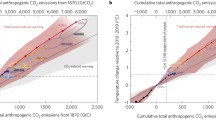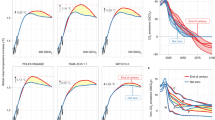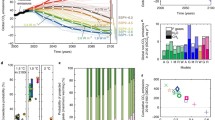Abstract
This study explores the feasibility of limiting increases in global temperature to 1.5°C above pre-industrial levels. A probabilistic simple climate model is used to identify emissions paths that offer at least a 50% chance of achieving this goal. We conclude that it is more likely than not that warming would exceed 1.5°C, at least temporarily, under plausible mitigation scenarios. We have identified three criteria of emissions paths that could meet the 1.5°C goal with a temporary overshoot of no more than 50 years: early and strong reductions in emissions, with global emissions peaking in 2015 and falling to at most 44–48 GtCO2e in 2020; rapid reductions in annual global emissions after 2020 (of at least 3–4% per year); very low annual global emissions by 2100 (less than 2–4 GtCO2e) and falling to zero (or below) in the 22nd century. The feasibility of these characteristics is uncertain. We conclude that the proposed date of review of the 1.5°C goal, set at 2015, may be too late to achieve the necessary scaling up of emissions cuts to achieve this goal.


Similar content being viewed by others
Notes
All probability estimates are rounded to the nearest 5%.
The range of emissions in 2020 is consistent with the set of 2°C paths developed in Ranger et al. (2009).
Gohar and Lowe (2009) describe a large database of emissions paths. We extract only those 14 paths where Gohar and Lowe estimate a median peak warming of 2°C or below between 2000 and 2200. Each has a different combination of: the year of the peak in global emissions (2014, 2016 or 2020); the annual rate of emissions reductions following the peak (3 to 6% per year, measured in CO2 emissions); and the emissions floor (zero or non-zero emissions in the long-term). The resulting 2020 emissions of these paths are between 44 and 57 GtCO2e and emissions fall to between 3 and 7 GtCO2e by 2100. The paths that have a non-zero emissions floor asymptote to 6 GtCO2e (scenarios B:5, B:6 and B:7) while for the other paths, emissions fall to zero by 2200. For more details see the Supplementary material B
The 2100 radiative forcing simulated in this study for all aerosols is −1.3Wm−2 compared to −5.3Wm−2 for RCP3-PD from the RCP database
The Set B paths tend to require stronger action than for Set A (in terms of both 2020 emissions and the rate of decline post-2020) to meet the same goal. This results from the higher emissions post-2050 for the Set B paths. Indeed, under the low aerosol scenario, no Set B paths are able to meet the goal; hence, action would need to be stronger than demonstrated by the Set B paths.
The temperature reduction seen at the 50th percentile for an emissions based simulation using the RCP3-PD scenario
References
Arora VK, Scinocca JF, Boer GJ, Christian JR, Denman KL, Flato GM, Kharin VV, Lee WG, Merryfield WJ (2011) Carbon emission limits required to satisfy future representative concentration pathways of greenhouse gases. Geophys Res Lett 38:L05805. doi:10.1029/2010GL046270
Clarke L, Edmonds J, Krey V, Richels R, Rose S, Tavoni M (2009) International climate policy architectures: overview of the EMF 22 International Scenarios. Energ Econ 31:S64–S81
Edenhofer O, Carraro C, Hourcade J-C et al (2009) The Economics of Decarbonization. Report of the RECIPE project. Potsdam Institute for Climate Impact Research, Potsdam
Gohar LK and Lowe JA (2009) Summary of the emissions mitigation scenarios: part 1.Work stream 1, Report 2 of the AVOID programme (AV/WS1/D1/R02). Available online at www.avoid.uk.net
Good P, Gregory JM, Lowe JA and Andrew T Predicting and understanding CMIP5 representive concentration pathway projections using the response to abrupt CO2 change. Submitted to Climate Dynamics
Ha-Duong M, Grubb MJ, Hourcad J-C (1997) Influence of socioeconomic inertia and uncertainty on optimal CO2-emission abatement. Nature 390:270–273
Knopf B, Edenhofer O, Barker T et al (2009) The economics of low stabilisation: implications for technological change and policy. In: Hulme M, Neufeldt H (eds) Making climate change work for us: ADAM synthesis book. Cambridge University Press, UK
Lowe JA, Huntingford C, Raper SCB, Jones CD, Liddicoat SK, Gohar LK (2009) How difficult is it to recover from dangerous levels of global warming? Environ Res Lett. doi:10.1088/1748-9326/4/1/014012
Magné B, Kypreos S, Turton H (2010) Technological options for low stabilisation pathways with MERGE. Energ J 31:83–107
Matthews HD, Weaver AJ (2010) Committed climate warming. Nat Geosci 3:142–143
Meinshausen M, Smith SJ, Calvin K, Daniel JS, Kainuma MLT, Larmarque JF, Matsumoto K, Montzka SA, Raper SCB, Riahi K, Thomson A, Velders GJM, van Vuuren DPP (2011) The RCP greenhouse gas concentrations and their extensions from 1765 to 2300. Clim Chang 109:213–241
Moss RH, Edmonds JA, Hibbard KA et al (2010) The next generation of scenarios for climate change research and assessment. Nature. doi:10.1038/nature08823
Plattner GK, Knutti R, Joos F et al (2008) Long-term climate commitments projected with climate-carbon cycle models. J Climate 21:2721–2751
Ranger N, Bowen A, Lowe J and Gohar L (2009) Mitigating climate change through reductions in greenhouse gas emissions: climate science constraints on annual global emissions targets for 2020 and 2050. In “Mitigating climate change through reductions in greenhouse gas emissions: the science and economics of future paths for global annual emissions” [Bowen, A and Ranger, N.] Grantham/CCCEP Policy Brief No. 2. http://www2.lse.ac.uk/GranthamInstitute/publications/Policy/docs/PBMitigatingBowenRangerDec09.pdf
Royal Society (2009) Geoengineering the climate: science, governance and uncertainty, Royal Society Policy document 10/09, ISBN: 978-0-85403-773-5
Schewe J, Levermann A, Meinshausen M (2011) Climate change under a scenario near 1.5°C of global warming: monsoon intensification, ocean warming and steric sea level rise. Earth Syst Dynam 2:25–35
United Nations Environment Programme (UNEP) (2010) The Emissions Gap Report: are the Copenhagen Accord Pledges sufficient to limit global warming to 2C or 1.5C. http://www.unep.org/publications/ebooks/emissionsgapreport. Accessed 5th September 2011
UNEP (2011) Bridging the Emissions Gap. United Nations Environment Programme (UNEP). http://www.unep.org/pdf/UNEP_bridging_gap.. Accessed 21st December 2011
van Vuuren DP, den Elzen MGJ, Lucas PL, Eickhout B, Strengers BJ, van Ruijven B, Wonink S, van Houdt R (2007) Stablizing greenhouse gas concentrations at low levels: an assessment of reduction strategies and costs. Clim Chang 81:119–159
van Vuuren DP, Stehfest E, den Elzen MGJ (2011) RCP2.6: exploring the possibility to keep global mean temperature increase below 2°C. Clim Chang 109:95–116
Wigley TML, Raper SCB (2001) Interpretation of high projections for global-mean warming. Science 293:451–454
Wise M, Calvin K, Thomson A, Clarke L, Bond-Lamberty B, Sands R, Smith SJ, Janetos A, Edmonds J (2009) Implications for limiting CO2 concentrations for land use and energy. Science 324:1183–1186
Acknowledgements
The authors wish to thank Brian Hoskins, Andrew Gouldson, Piers Forster, Nicholas Stern and the two anonymous reviewers for their comments. Nicola Ranger, Alex Bowen and Robert Ward were supported during this project by Grantham Foundation for the Protection of the Environment and the UK Economic and Social Research Council (ESRC). Laila Gohar and Jason Lowe were supported during this project by the AVOID programme funded by the UK Department of Energy and Climate Change (DECC) and Department for Environment, Food and Rural Affairs (Defra), under contract DECC/Defra GA0215. The Met Office Hadley Centre provided scientific input to this work but does not advocate particular policy choices.
Author information
Authors and Affiliations
Corresponding author
Electronic supplementary material
Below is the link to the electronic supplementary material.
ESM 1
(DOC 178 kb)
Rights and permissions
About this article
Cite this article
Ranger, N., Gohar, L.K., Lowe, J.A. et al. Is it possible to limit global warming to no more than 1.5°C?. Climatic Change 111, 973–981 (2012). https://doi.org/10.1007/s10584-012-0414-8
Received:
Accepted:
Published:
Issue Date:
DOI: https://doi.org/10.1007/s10584-012-0414-8




